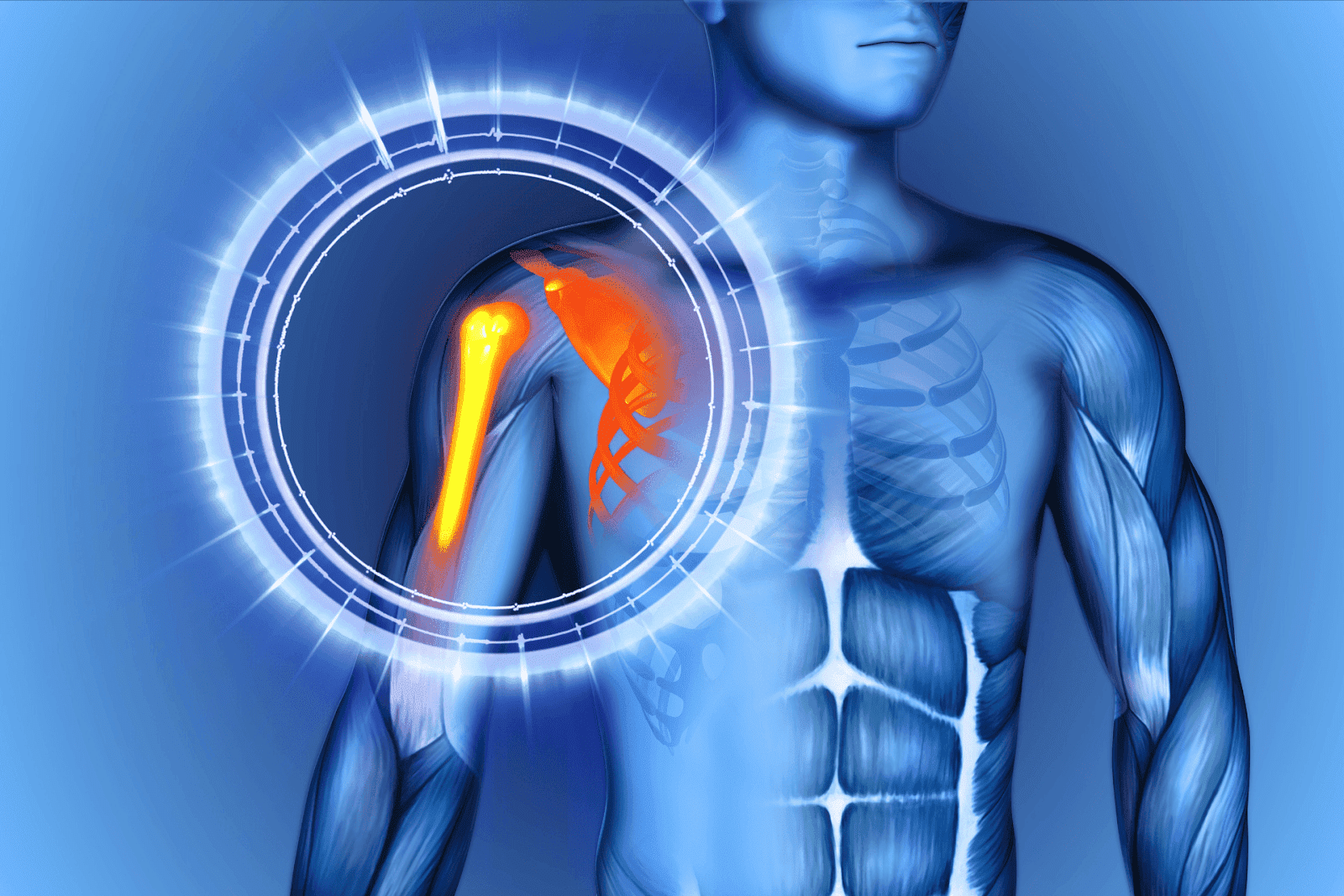Zepbound and Nausea - How to Manage It
Key TakeawaysZepbound (tirzepatide) is an FDA-approved medication for chronic weight management and improving obstructive sleep apnea through weight loss.Nausea is a common [...]
Read More
Medically reviewed by Abhijit Bhattacharyya | MD, PhD, MBA, Tufts University School of Medicine - Miami, Florida on August 15th, 2025.
The shoulder is one of the most complex and flexible joints in the human body, allowing a wide range of motion that enables countless daily activities. But with this complexity comes vulnerability. Shoulder pain is a common complaint that can stem from a variety of causes, ranging from minor strains to serious medical conditions. Understanding the root cause of a sore shoulder is essential for effective treatment and recovery.
 Understanding Shoulder Anatomy and Why It Hurts
Understanding Shoulder Anatomy and Why It HurtsThe shoulder joint is a ball-and-socket joint formed by the humerus (upper arm bone), the scapula (shoulder blade), and the clavicle (collarbone). This joint is supported by muscles, tendons, ligaments, and bursae that work together to provide stability and movement. The rotator cuff, a group of four muscles and their associated tendons, plays a crucial role in keeping the shoulder joint stable while allowing for a wide range of motion. This intricate arrangement enables activities such as throwing, lifting, and reaching, which are essential for daily tasks and athletic performance.
Because the shoulder has such a wide range of motion, it is susceptible to injuries and conditions that can cause pain. The pain may be localized to the shoulder itself or may radiate down the arm or up into the neck, making it sometimes difficult to pinpoint the exact source. Common injuries include rotator cuff tears, shoulder impingement, and tendinitis, each of which can arise from acute trauma or chronic overuse. Factors such as age, occupation, and physical activity level can also influence the likelihood of developing shoulder pain, highlighting the importance of understanding one's own body mechanics and limitations.
Common symptoms accompanying shoulder pain include stiffness, swelling, weakness, and limited range of motion. These symptoms can provide clues to the underlying cause. For instance, a sharp pain that occurs during specific movements may indicate a rotator cuff injury, while a dull ache that persists at rest could suggest arthritis or bursitis. Additionally, referred pain from conditions affecting the neck or spine can complicate diagnosis, necessitating a thorough evaluation by a healthcare professional. Early intervention and appropriate treatment are essential to prevent further damage and to restore function, making awareness of shoulder anatomy and potential issues critical for maintaining an active lifestyle.
The rotator cuff is a group of four muscles and their tendons that stabilize the shoulder and allow for lifting and rotating the arm. Rotator cuff injuries are among the most frequent causes of shoulder pain, especially in people over 40 or those who perform repetitive overhead activities.
Injuries can range from inflammation (tendinitis) to partial or complete tears. Symptoms typically include a dull ache deep in the shoulder, weakness when lifting the arm, and pain that worsens at night. Treatment options often include physical therapy, anti-inflammatory medications, and in severe cases, surgical intervention to repair the torn tendons. Early diagnosis and intervention can significantly improve recovery outcomes and restore function.
Frozen shoulder is characterized by stiffness and pain in the shoulder joint, leading to a significant reduction in mobility. It often develops gradually and can last for months or even years if untreated.
This condition is more common in people with diabetes, thyroid disorders, or those who have had prolonged immobilization of the shoulder due to injury or surgery. The process of recovery can be frustrating, as it typically involves a combination of physical therapy, pain management, and sometimes corticosteroid injections to reduce inflammation. Understanding the stages of frozen shoulder can help patients manage their expectations and adhere to treatment protocols effectively.
Bursae are small fluid-filled sacs that cushion the bones, tendons, and muscles around the joints. When these sacs become inflamed, usually due to repetitive motion or trauma, it results in bursitis, causing sharp or achy pain and swelling.
This condition can affect anyone, but athletes and individuals with occupations that require repetitive overhead movements are particularly at risk. Treatment often includes rest, ice application, and anti-inflammatory medications. In some cases, physical therapy may be recommended to strengthen the surrounding muscles and improve flexibility, ultimately preventing future episodes of bursitis.
Osteoarthritis or rheumatoid arthritis can affect the shoulder joint, leading to pain, swelling, and decreased range of motion. This is more common in older adults and may develop gradually over time.
Arthritis in the shoulder can significantly impact daily activities, making simple tasks like reaching for an item on a shelf or lifting a grocery bag painful and challenging. Treatment options vary based on the severity of the condition and may include lifestyle modifications, physical therapy, and medications to manage pain and inflammation. In advanced cases, surgical options such as joint replacement may be considered to restore function and alleviate discomfort.
A dislocated shoulder occurs when the upper arm bone pops out of the socket. This injury is often caused by trauma or sports injuries and results in severe pain, swelling, and an inability to move the arm.
Shoulder instability can also occur without full dislocation, leading to recurring pain and a feeling that the shoulder may “give out.” Rehabilitation is crucial for restoring stability and strength to the shoulder, often involving targeted exercises to strengthen the rotator cuff and surrounding muscles. In some cases, surgical intervention may be necessary to repair damaged ligaments or restore proper joint alignment.
Sometimes, shoulder pain is not caused by a problem in the shoulder itself but is referred pain from other areas such as the neck, heart, or lungs. For example, a heart attack can cause pain radiating to the left shoulder, which requires immediate medical attention.
Additionally, conditions such as cervical radiculopathy, where nerve roots in the neck are compressed, can lead to pain that mimics shoulder issues. It’s essential for individuals experiencing unexplained shoulder pain to consult a healthcare professional for a thorough evaluation to rule out serious underlying conditions and receive appropriate treatment. Understanding the complexity of shoulder pain can empower patients to seek timely care and improve their overall quality of life.
While many shoulder pains resolve with rest and home care, certain signs indicate the need for professional evaluation:
Severe pain that does not improve with rest or over-the-counter medications
Sudden inability to move the shoulder or arm
Visible deformity or swelling
Numbness, tingling, or weakness in the arm or hand
Shoulder pain accompanied by chest pain, shortness of breath, or dizziness
Early diagnosis and treatment can prevent complications and speed recovery.
Diagnosing the cause of shoulder pain typically involves a combination of a detailed medical history, physical examination, and imaging tests.
Healthcare providers will ask about the onset, duration, and nature of the pain, as well as any recent injuries or activities that may have contributed. Physical tests assess the range of motion, strength, and areas of tenderness.
Imaging studies such as X-rays, MRI scans, or ultrasound may be used to visualize bones, muscles, tendons, and other soft tissues to identify tears, inflammation, or arthritis.
In today’s fast-paced world, accessing quality healthcare quickly and conveniently is crucial. Telehealth services have revolutionized how patients receive medical care, especially for non-emergency conditions like shoulder pain.
Doctronic.ai stands out as a leading AI-powered telehealth platform offering direct-to-patient care that is fast, smart, and personal. With Doctronic, you can have a free AI doctor visit anytime to get an initial diagnosis and treatment recommendations based on the latest peer-reviewed medical research.
This service is especially valuable for those unsure whether their shoulder pain requires urgent care or can be managed conservatively. After the AI visit, you can also book an inexpensive telehealth video visit with a licensed doctor for further evaluation and personalized care, available 24/7 across all 50 states.
Giving the shoulder adequate rest and avoiding activities that exacerbate pain is often the first step in treatment. However, complete immobilization is generally discouraged unless recommended by a healthcare provider, as gentle movement helps prevent stiffness.
Applying ice packs during the first 48 hours after injury can reduce inflammation and numb pain. Heat therapy may be beneficial later to relax muscles and improve blood flow.
Nonsteroidal anti-inflammatory drugs (NSAIDs) like ibuprofen or naproxen can alleviate pain and reduce inflammation. Always follow dosing instructions and consult a healthcare provider if you have underlying health conditions.
Targeted exercises and physical therapy can strengthen shoulder muscles, improve flexibility, and restore function. A physical therapist can design a personalized program based on the specific diagnosis.
 Medical Interventions
Medical InterventionsIn some cases, corticosteroid injections may be recommended to reduce severe inflammation. Surgical options are considered for significant injuries such as rotator cuff tears or persistent instability that do not respond to conservative treatment.
Prevention is always better than a cure. Simple lifestyle adjustments can reduce the risk of developing shoulder pain:
Maintain good posture, especially when sitting or working at a desk
Warm up and stretch before engaging in physical activities or sports
Avoid repetitive overhead movements or take frequent breaks
Strengthen shoulder and upper back muscles through regular exercise
Use proper techniques when lifting heavy objects
When faced with shoulder pain, quick and accurate information is invaluable. Doctronic.ai leverages cutting-edge artificial intelligence to provide comprehensive, evidence-based answers in seconds. Unlike traditional telehealth platforms, Doctronic’s AI doctor remembers every visit and personal detail, offering a uniquely personalized experience.
With over 10 million users and growing rapidly, Doctronic combines the latest in modern medicine with unlimited patience and accessibility. Whether you need a quick diagnosis, second opinion, or affordable video consultation with a licensed physician, Doctronic is revolutionizing how shoulder pain and other health concerns are managed.
Shoulder pain can be caused by a wide range of factors, from minor strains to serious medical conditions. Understanding the possible causes and knowing when to seek medical advice are critical steps toward effective treatment and recovery.
Thanks to advances in telehealth and AI technology, Doctronic.ai makes it easier than ever to get fast, smart, and personal care from the comfort of home. If you’re experiencing persistent or severe shoulder pain, consider starting with a free AI doctor visit on Doctronic.ai to get the answers you need quickly and confidently.
Don't let shoulder pain slow you down. With Doctronic, you can access the #1 AI Doctor for an immediate, free AI doctor visit that's fast, smart, and personal. Our AI-powered platform offers you the most up-to-date medical advice based on peer-reviewed research, tailored specifically to your health needs. And if you need more, our telehealth video visits with licensed doctors are available 24/7 in all 50 states, for less than $40. Skip the line. Talk to an AI Doctor Now, for free.
Key TakeawaysZepbound (tirzepatide) is an FDA-approved medication for chronic weight management and improving obstructive sleep apnea through weight loss.Nausea is a common [...]
Read MoreKey TakeawaysZepbound is an FDA-approved medication for chronic weight management and obesity-related obstructive sleep apnea (OSA).Prior authorization is often required by [...]
Read MoreKey TakeawaysZepbound (tirzepatide) is an FDA-approved medication primarily for weight management and improving obstructive sleep apnea by reducing body fat.Diarrhea is a [...]
Read More